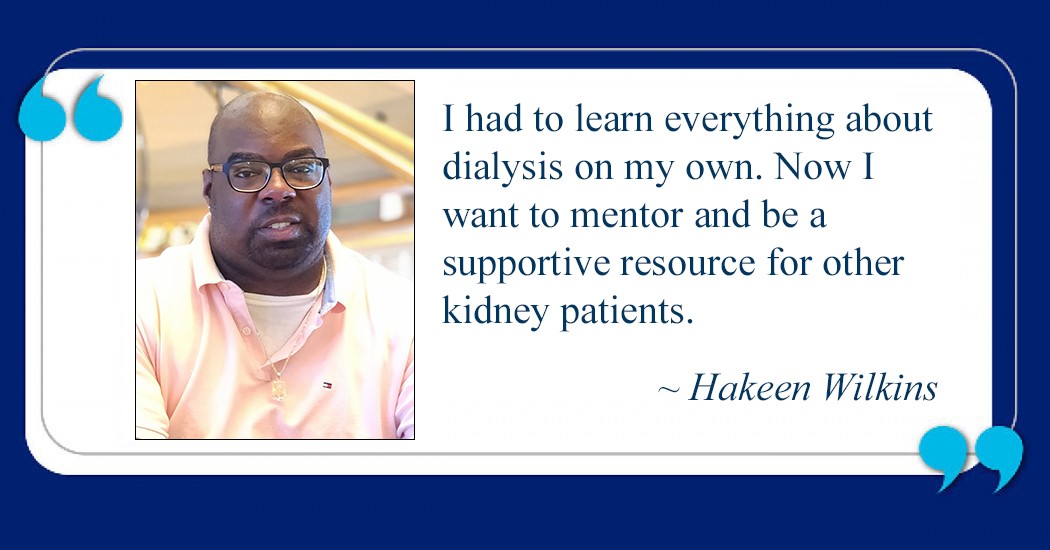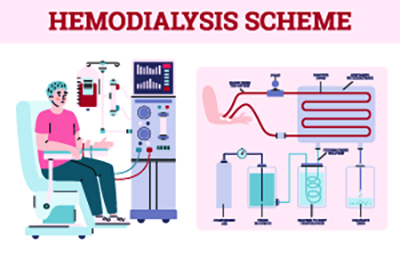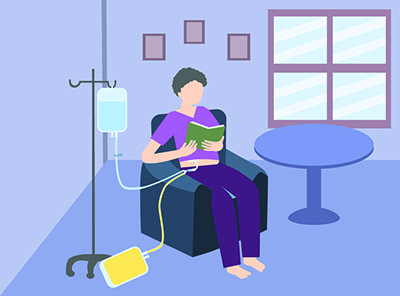Superb kidney care motivates Wilkins to mentor others

Hakeen Wilkins and his doctor had known for a while that his kidneys were slowly losing the ability to filter out impurities in his blood system. One of the numbers they closely monitored was Wilkin’s creatinine level, which indicated how well his kidneys were working.
Creatine is a waste product produced by muscles. Healthy kidneys filter the blood that flows through it, removing creatine and other substances before sending the impurities out through urine. High levels of creatinine in the blood can be a signal that the kidneys are not functioning properly.
“I had lab work that week on another blood sample,” recalled Wilkins, a 42-year-old resident of West Orange, New Jersey. “So, when my doctor asked me to visit his office on Monday, I suspected we would talk about the lab results.”
Creatinine levels are considered high when above 1.2 milligrams for males and 1.0 milligrams for females. “At the appointment, I found out that my creatinine level had spiked to the 5.0 to 6.0 milligram range,” said Wilkins.
Despite the high levels, Wilkins still wanted to avoid dialysis.
“My doctor referred me to a kidney specialist who prescribed different medications to lower my creatinine level,” he said. “Unfortunately, they didn’t work. When I started having muscle spasms in my legs, my creatinine had spiked to 7.2, so I knew I had to start dialysis.”
As he prepared to start dialysis, Wilkins also hoped that he would someday receive a kidney transplant, so he put his name on the National Kidney Registry.
 Dialysis
Dialysis
During the six and a half years he was on dialysis, Wilkins underwent two kinds of dialysis: hemodialysis and peritoneal dialysis.
With hemodialysis, a machine filters the wastes, salts, and fluid from the blood when the kidneys are no longer healthy enough to do this work adequately. Hemodialysis is a good way to treat advanced kidney failure and helps patients carry on an active life despite failing kidneys.
Peritoneal dialysis is less involved and can be done at home. During this procedure, a cleansing fluid called dialysate passes through a catheter tube into part of the patient’s abdomen known as the peritoneal cavity. The dialysate absorbs waste products from blood vessels in the lining of the abdomen, called the peritoneum. Then the fluid is drawn back out of the body and discarded.
 Wilkins started with hemodialysis sessions at Mountainside Medical Center to help quickly lower his creatinine level. After three months, he transitioned to peritoneal dialysis at home.
Wilkins started with hemodialysis sessions at Mountainside Medical Center to help quickly lower his creatinine level. After three months, he transitioned to peritoneal dialysis at home.
Dialysis Training
Wilkins started his dialysis training at Mountainside Medical Center in 2016.
“The staff at Mountainside treated me like I was a king,” recalled Wilkins. “It didn’t matter if I was an inpatient or visiting an outpatient clinic, my care was outstanding. This was so new to me at the beginning, but they told me ‘It's all going to be OK.’”
Anne Marie, one of the outpatient nurses, taught Wilkins how to run peritoneal dialysis by himself.
“I called Anne Marie for just about anything,” said Wilkins. “It didn't matter what time of the day or night it was. If I had an issue or problem with my machine, she always answered the phone like she was awake. To this day, the nurses like Anne Marie and Jewel are like family to me.”
After six and a half years on the transplant list, Wilkins received a kidney from a deceased donor in April 2022.
“The kidney is working excellently,” he reported. “I'm taking the anti-rejection medication like I'm supposed to. My blood numbers and urine analysis are good. The staff says I'm doing exactly what I'm supposed to do to care for this kidney.”
Mentor to others
With no family history of kidney disease, Wilkins was highly motivated to learn everything he could do to stay healthy. His experience helped him to realize that he could help other people learn how to live with the disease.
“I’ve been through everything, so I can tell others what to expect, such as the different types of dialysis, medications, procedures, and what to expect when going through the transplant process,” he said. “Dialysis is not ‘the end of the world,’ so if you have questions or need to talk to someone to talk to, I can help. I didn't have anybody to help me, so I can really help others. This is something that's near and dear to my heart.”
Travel plans
Now that life is better with his new kidney, Wilkins is looking forward to traveling more.
“My aunt took me on my first cruise for my birthday in June and I hope to return to New Orleans soon,” he said. “I didn’t get to eat any spicy food the last time I was there because I had to be mindful of my creatinine and potassium levels. Since I can eat more options, I'm looking forward to enjoying the full New Orleans experience.”
There has also been a positive change in his outlook on life, which he hopes to pass along to the people he mentors.
“As long as I'm able to get up in the morning, get out, hop onto public transit to see people, and move around, I’m good,” said Wilkins. “I’m in a much better place now and I’m not letting anything, or anyone stop me.”
For more information about the Dialysis Center at Mountainside Medical Center, visit our website.




